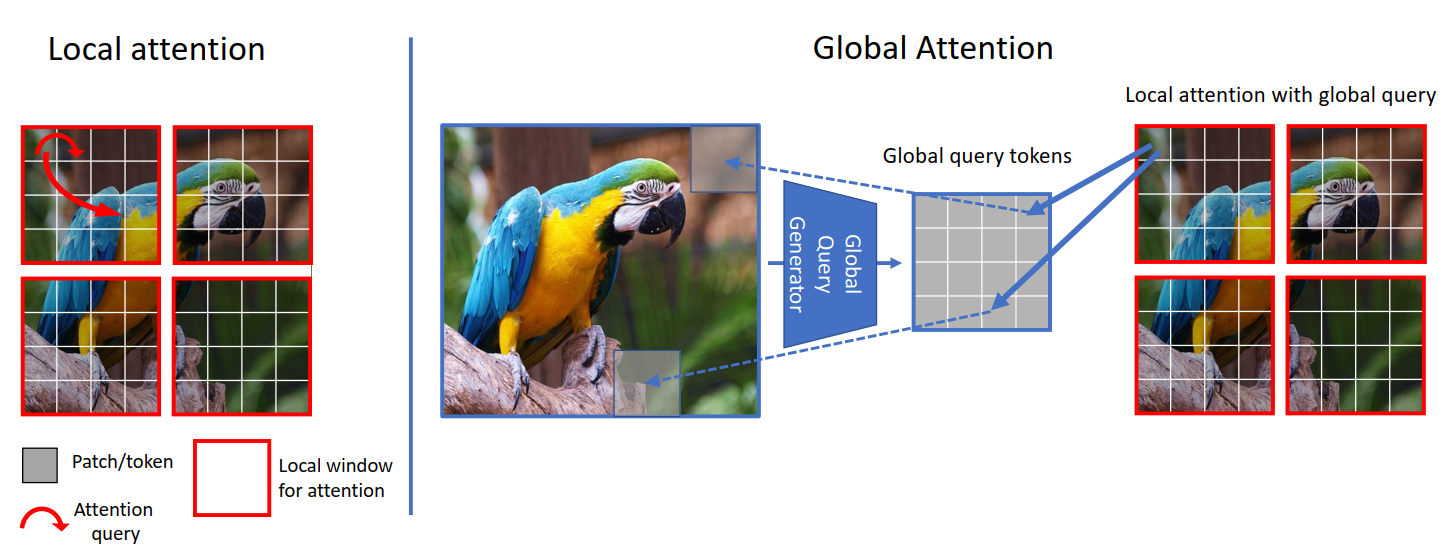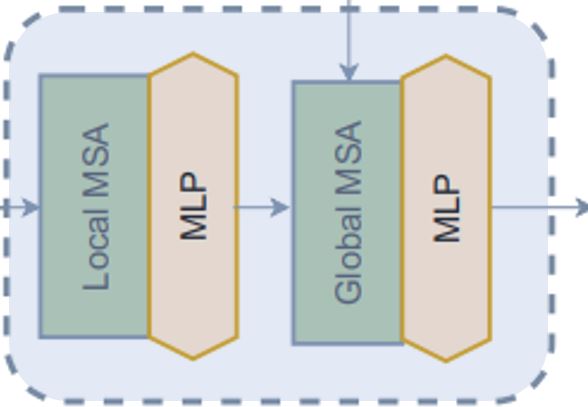使用全局上下文视觉Transformer进行图像分类
作者: Md Awsafur Rahman
创建日期 2023/10/30
最后修改日期 2023/10/30
描述: 全局上下文视觉Transformer在图像分类中的实现和微调。
设置
!pip install --upgrade keras_cv tensorflow
!pip install --upgrade keras
import keras
from keras_cv.layers import DropPath
from keras import ops
from keras import layers
import tensorflow as tf # only for dataloader
import tensorflow_datasets as tfds # for flower dataset
from skimage.data import chelsea
import matplotlib.pyplot as plt
import numpy as np
简介
在本笔记本中,我们将利用多后端 Keras 3.0 来实现 A Hatamizadeh 等人在 ICML 2023 上发表的 GCViT: Global Context Vision Transformer 论文。然后,我们将利用官方 ImageNet 预训练权重,在 Flower 数据集上对模型进行图像分类任务的微调。本笔记本的亮点在于其与多个后端(TensorFlow、PyTorch 和 JAX)的兼容性,展示了多后端 Keras 的真正潜力。
动机
注意: 在本节中,我们将了解GCViT的背景故事,并尝试理解其提出的原因。
- 近年来,Transformer 在自然语言处理(NLP)任务中占据主导地位,其自注意力机制能够捕获长距离和短距离信息。
- 顺应这一趋势,视觉 Transformer(ViT)提出将图像块作为标记,构建一个类似于原始 Transformer 编码器的庞大架构。
- 尽管卷积神经网络(CNN)在计算机视觉领域曾长期占据主导地位,但基于 ViT 的模型已在各种计算机视觉任务中展现出SOTA(State-of-the-Art)或具有竞争力的性能。

- 然而,自注意力的**二次(`O(n^2)`)计算复杂度**以及**缺乏多尺度信息**使得 **ViT** 难以被视为适用于分割和目标检测等需要**像素级别密集预测**的通用计算机视觉架构。
- Swin Transformer试图通过提出多分辨率/分层架构来解决**ViT**的问题,其中自注意力在局部窗口中计算,并使用窗口移位等跨窗口连接来模拟不同区域之间的交互。但是,**局部窗口的有限感受野**无法捕获长距离信息,并且**窗口移位**等跨窗口连接方案**仅覆盖每个窗口附近的小邻域**。此外,它缺乏**归纳偏置**,而归纳偏置鼓励一定的平移不变性,这对于通用视觉建模仍然是首选,特别是对于目标检测和语义分割等密集预测任务。
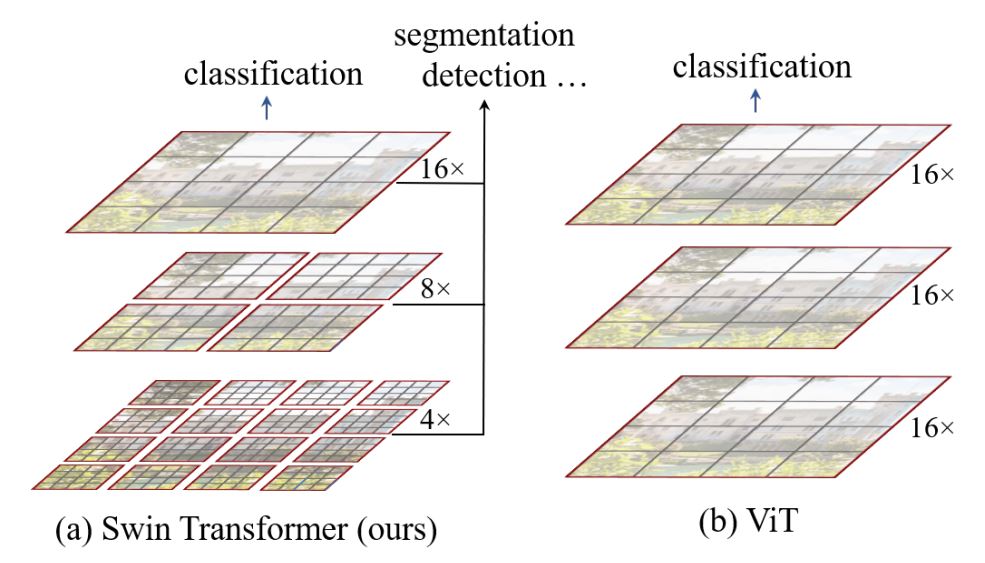

- 为了解决上述限制,提出了全局上下文(GC)ViT网络。
架构
让我们快速概览一下关键组件:1. Stem/PatchEmbed: 网络起始处的干/分块层处理图像。对于此网络,它创建图像块/令牌并将其转换为嵌入。2. Level: 它是重复的构建块,使用不同的块提取特征。3. Global Token Gen./FeatureExtraction: 它使用深度卷积神经网络(Depthwise-CNN)、SqueezeAndExcitation(挤压-激励)、CNN 和最大池化(MaxPooling)生成全局令牌/图像块。因此,它本质上是一个特征提取器。4. Block: 它是重复模块,将注意力应用于特征并将其投射到特定维度。1. Local-MSA: 局部多头自注意力。2. Global-MSA: 全局多头自注意力。3. MLP: 将向量投射到另一个维度的线性层。5. Downsample/ReduceSize: 它与Global Token Gen.模块非常相似,只是它使用CNN代替MaxPooling进行下采样,并增加了层归一化(Layer Normalization)模块。6. Head: 它是负责分类任务的模块。1. Pooling: 将N x 2D特征转换为N x 1D特征。2. Classifier: 处理N x 1D特征以做出类别决策。
我已对架构图进行了标注,以便于理解,
单元块
注意: 这些块用于构建论文中的其他模块。大多数块要么借用自其他工作,要么是旧工作的修改版本。
-
SqueezeAndExcitation: Squeeze-Excitation (SE) 又名 **Bottleneck** 模块,扮演着一种通道注意力的角色。它由平均池化 (AvgPooling)、全连接层 (Dense/FullyConnected (FC)/Linear)、GELU 和 Sigmoid 模块组成。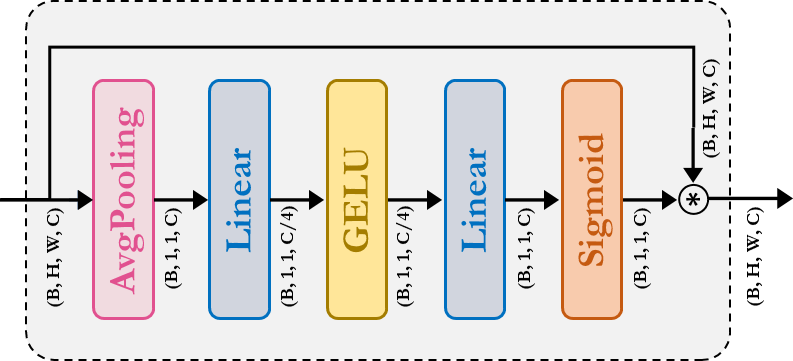
-
Fused-MBConv:这与 **EfficientNetV2** 中使用的类似。它使用 **深度卷积 (Depthwise-Conv)**、**GELU**、**SqueezeAndExcitation**、**卷积 (Conv)** 来提取具有残差连接的特征。请注意,没有为它声明新的模块,我们只是直接应用了相应的模块。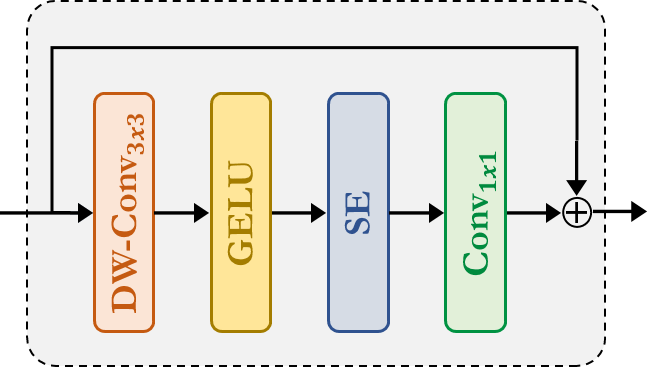
-
ReduceSize:这是一个基于 **CNN** 的 **下采样** 模块,它使用上述的Fused-MBConv模块来提取特征,使用 **步进卷积 (Strided Conv)** 同时减小空间维度并增加特征的通道维度,最后使用 **层归一化 (LayerNormalization)** 模块来归一化特征。在论文/图中,这个模块被称为 **下采样** 模块。我认为值得一提的是,**SwinTransformer** 使用PatchMerging模块而不是ReduceSize来减小空间维度和增加通道维度,它使用 **全连接/密集/线性** 模块。根据 **GCViT** 论文,使用ReduceSize的目的之一是通过 **CNN** 模块添加归纳偏置。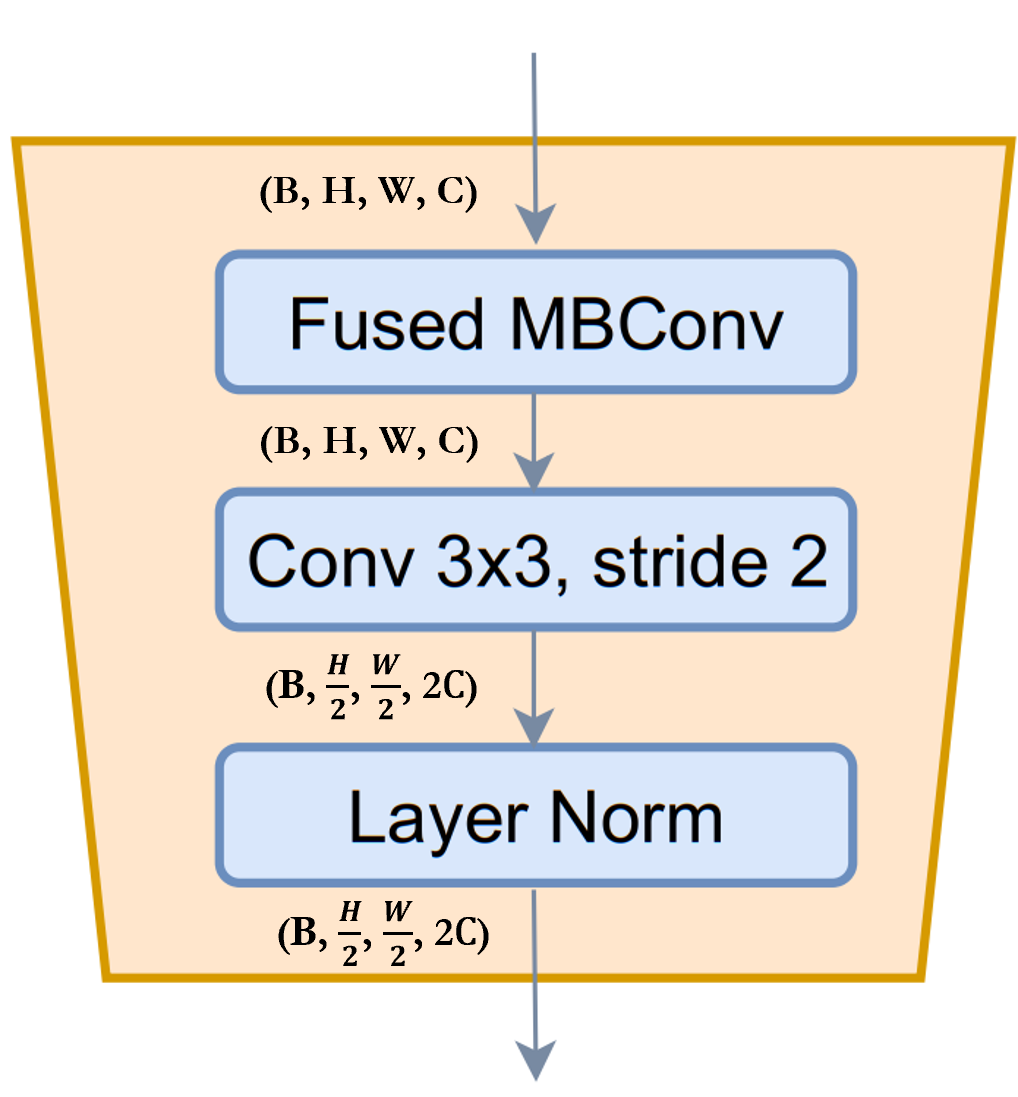
-
MLP:这是我们自己的多层感知器模块。这是一个前馈/全连接/线性模块,它只是将输入投影到任意维度。
class SqueezeAndExcitation(layers.Layer):
"""Squeeze and excitation block.
Args:
output_dim: output features dimension, if `None` use same dim as input.
expansion: expansion ratio.
"""
def __init__(self, output_dim=None, expansion=0.25, **kwargs):
super().__init__(**kwargs)
self.expansion = expansion
self.output_dim = output_dim
def build(self, input_shape):
inp = input_shape[-1]
self.output_dim = self.output_dim or inp
self.avg_pool = layers.GlobalAvgPool2D(keepdims=True, name="avg_pool")
self.fc = [
layers.Dense(int(inp * self.expansion), use_bias=False, name="fc_0"),
layers.Activation("gelu", name="fc_1"),
layers.Dense(self.output_dim, use_bias=False, name="fc_2"),
layers.Activation("sigmoid", name="fc_3"),
]
super().build(input_shape)
def call(self, inputs, **kwargs):
x = self.avg_pool(inputs)
for layer in self.fc:
x = layer(x)
return x * inputs
class ReduceSize(layers.Layer):
"""Down-sampling block.
Args:
keepdims: if False spatial dim is reduced and channel dim is increased
"""
def __init__(self, keepdims=False, **kwargs):
super().__init__(**kwargs)
self.keepdims = keepdims
def build(self, input_shape):
embed_dim = input_shape[-1]
dim_out = embed_dim if self.keepdims else 2 * embed_dim
self.pad1 = layers.ZeroPadding2D(1, name="pad1")
self.pad2 = layers.ZeroPadding2D(1, name="pad2")
self.conv = [
layers.DepthwiseConv2D(
kernel_size=3, strides=1, padding="valid", use_bias=False, name="conv_0"
),
layers.Activation("gelu", name="conv_1"),
SqueezeAndExcitation(name="conv_2"),
layers.Conv2D(
embed_dim,
kernel_size=1,
strides=1,
padding="valid",
use_bias=False,
name="conv_3",
),
]
self.reduction = layers.Conv2D(
dim_out,
kernel_size=3,
strides=2,
padding="valid",
use_bias=False,
name="reduction",
)
self.norm1 = layers.LayerNormalization(
-1, 1e-05, name="norm1"
) # eps like PyTorch
self.norm2 = layers.LayerNormalization(-1, 1e-05, name="norm2")
def call(self, inputs, **kwargs):
x = self.norm1(inputs)
xr = self.pad1(x)
for layer in self.conv:
xr = layer(xr)
x = x + xr
x = self.pad2(x)
x = self.reduction(x)
x = self.norm2(x)
return x
class MLP(layers.Layer):
"""Multi-Layer Perceptron (MLP) block.
Args:
hidden_features: hidden features dimension.
out_features: output features dimension.
activation: activation function.
dropout: dropout rate.
"""
def __init__(
self,
hidden_features=None,
out_features=None,
activation="gelu",
dropout=0.0,
**kwargs,
):
super().__init__(**kwargs)
self.hidden_features = hidden_features
self.out_features = out_features
self.activation = activation
self.dropout = dropout
def build(self, input_shape):
self.in_features = input_shape[-1]
self.hidden_features = self.hidden_features or self.in_features
self.out_features = self.out_features or self.in_features
self.fc1 = layers.Dense(self.hidden_features, name="fc1")
self.act = layers.Activation(self.activation, name="act")
self.fc2 = layers.Dense(self.out_features, name="fc2")
self.drop1 = layers.Dropout(self.dropout, name="drop1")
self.drop2 = layers.Dropout(self.dropout, name="drop2")
def call(self, inputs, **kwargs):
x = self.fc1(inputs)
x = self.act(x)
x = self.drop1(x)
x = self.fc2(x)
x = self.drop2(x)
return x
干
注意:在代码中,此模块被称为 PatchEmbed,但在论文中,它被称为 Stem。
在模型中,我们首先使用了patch_embed模块。让我们尝试理解这个模块。从call方法中我们可以看到:1. 这个模块首先对输入进行填充。2. 然后使用卷积提取带有嵌入的图像块。3. 最后,使用ReduceSize模块首先用卷积提取特征,但既不减小空间维度也不增加空间维度。4. 一个重要的注意事项是,与ViT或SwinTransformer不同,GCViT创建了重叠的图像块。我们可以从代码中注意到这一点:Conv2D(self.embed_dim, kernel_size=3, strides=2, name='proj')。如果我们想要非重叠的图像块,那么我们应该使用相同的kernel_size和stride。5. 这个模块将输入的空间维度减小了4x。
总结:图像 → 填充 → 卷积 → (特征提取 + 下采样)
class PatchEmbed(layers.Layer):
"""Patch embedding block.
Args:
embed_dim: feature size dimension.
"""
def __init__(self, embed_dim, **kwargs):
super().__init__(**kwargs)
self.embed_dim = embed_dim
def build(self, input_shape):
self.pad = layers.ZeroPadding2D(1, name="pad")
self.proj = layers.Conv2D(self.embed_dim, 3, 2, name="proj")
self.conv_down = ReduceSize(keepdims=True, name="conv_down")
def call(self, inputs, **kwargs):
x = self.pad(inputs)
x = self.proj(x)
x = self.conv_down(x)
return x
全局令牌生成。
注意: 它是用于施加归纳偏置的两个 **CNN** 模块之一。
从上面的单元格可以看出,在level中我们首先使用了to_q_global/Global Token Gen./FeatureExtraction。让我们尝试理解它是如何工作的,
- 这个模块是
FeatureExtract模块的系列,根据论文,我们需要重复这个模块K次,其中K = log2(H/h),H = feature_map_height,W = feature_map_width。 FeatureExtraction:此层与ReduceSize模块非常相似,只是它使用MaxPooling模块来减小维度,它不会增加特征维度(通道维度),并且不使用LayerNormalizaton。此模块在Generate Token Gen.模块中重复使用,用于为全局上下文注意力生成全局令牌。- 从图中需要注意的一点是,全局令牌在整个图像中共享,这意味着我们只为图像中的所有局部令牌使用一个全局窗口。这使得计算非常高效。
- 对于形状为
(B, H, W, C)的输入特征图,我们将得到输出形状(B, h, w, C)。如果我们将这些全局令牌复制到图像中的总M个局部窗口,其中M = (H x W)/(h x w) = num_window,则输出形状为:(B * M, h, w, C)。
总结:此模块用于
调整图像大小以适应窗口。
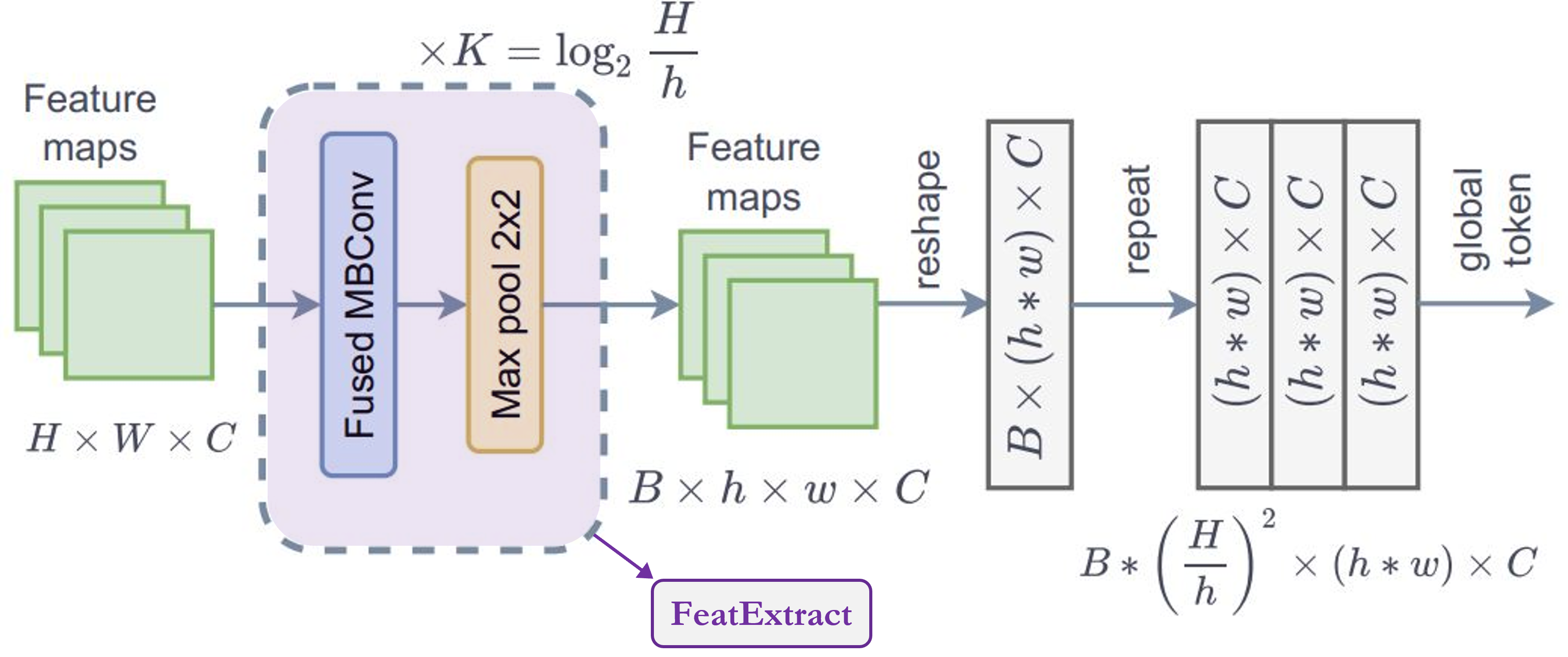
class FeatureExtraction(layers.Layer):
"""Feature extraction block.
Args:
keepdims: bool argument for maintaining the resolution.
"""
def __init__(self, keepdims=False, **kwargs):
super().__init__(**kwargs)
self.keepdims = keepdims
def build(self, input_shape):
embed_dim = input_shape[-1]
self.pad1 = layers.ZeroPadding2D(1, name="pad1")
self.pad2 = layers.ZeroPadding2D(1, name="pad2")
self.conv = [
layers.DepthwiseConv2D(3, 1, use_bias=False, name="conv_0"),
layers.Activation("gelu", name="conv_1"),
SqueezeAndExcitation(name="conv_2"),
layers.Conv2D(embed_dim, 1, 1, use_bias=False, name="conv_3"),
]
if not self.keepdims:
self.pool = layers.MaxPool2D(3, 2, name="pool")
super().build(input_shape)
def call(self, inputs, **kwargs):
x = inputs
xr = self.pad1(x)
for layer in self.conv:
xr = layer(xr)
x = x + xr
if not self.keepdims:
x = self.pool(self.pad2(x))
return x
class GlobalQueryGenerator(layers.Layer):
"""Global query generator.
Args:
keepdims: to keep the dimension of FeatureExtraction layer.
For instance, repeating log(56/7) = 3 blocks, with input
window dimension 56 and output window dimension 7 at down-sampling
ratio 2. Please check Fig.5 of GC ViT paper for details.
"""
def __init__(self, keepdims=False, **kwargs):
super().__init__(**kwargs)
self.keepdims = keepdims
def build(self, input_shape):
self.to_q_global = [
FeatureExtraction(keepdims, name=f"to_q_global_{i}")
for i, keepdims in enumerate(self.keepdims)
]
super().build(input_shape)
def call(self, inputs, **kwargs):
x = inputs
for layer in self.to_q_global:
x = layer(x)
return x
注意力
备注: 这是本文的核心贡献。
从call方法中可以看出,1. WindowAttention模块根据global_query参数应用局部和全局窗口注意力。
- 首先,它将输入特征转换为用于局部注意力的`query`、`key`、`value`,以及用于全局注意力的`key`、`value`。对于全局注意力,它从`Global Token Gen.`获取全局`query`。代码中值得注意的是,我们将在所有Transformer头部之间分配特征或嵌入维度以减少计算量。`qkv = tf.reshape(qkv, [B_, N, self.qkv_size, self.num_heads, C // self.num_heads])`
- 在将查询、键和值发送给注意力机制之前,全局令牌会经过一个重要的处理过程。为了提高效率,相同的全局令牌或一个全局窗口会被复制到所有局部窗口中。`q_global = tf.repeat(q_global, repeats=B_//B, axis=0)`,其中`B_//B`表示图像中的`num_windows`。
- 然后,根据
global_query参数简单地应用局部窗口自注意力或全局窗口注意力。代码中值得注意的是,我们将相对位置嵌入与注意力掩码相加,而不是与补丁嵌入相加。attn = attn + relative_position_bias[tf.newaxis,] - 现在,让我们思考一下,尝试理解这里发生了什么。让我们关注下面的图。我们可以从左侧看到,在局部注意力中,查询是局部的,并且它仅限于局部窗口(红色方框边框),因此我们无法访问长距离信息。但在右侧,由于全局查询,我们现在不再受限于局部窗口(蓝色方框边框),并且可以访问长距离信息。
- 在 **ViT** 中,我们比较(注意力)图像令牌与图像令牌,在 **SwinTransformer** 中,我们比较窗口令牌与窗口令牌,但在 **GCViT** 中,我们比较图像令牌与窗口令牌。但现在你可能会问,即使图像令牌的维度比窗口令牌大(从上图可以看出图像令牌的形状为 `(1, 8, 8, 3)`,窗口令牌的形状为 `(1, 4, 4, 3)`),我们如何比较(注意力)图像令牌与窗口令牌?是的,你说的没错,我们不能直接比较它们,因此我们使用 `Global Token Gen./FeatureExtraction` **CNN** 模块将图像令牌调整为适合窗口令牌的大小。下表应该能给你一个清晰的比较:
| 模型 | 查询令牌 | 键值令牌 | 注意力类型 | 注意力覆盖范围 |
|---|---|---|---|---|
| ViT | 图像 | 图像 | 自注意力 | 全局 |
| SwinTransformer | 窗口 | 窗口 | 自注意力 | 局部 |
| GCViT | 调整大小后的图像 | 窗口 | 图像-窗口注意力 | 全局 |
class WindowAttention(layers.Layer):
"""Local window attention.
This implementation was proposed by
[Liu et al., 2021](https://arxiv.org/abs/2103.14030) in SwinTransformer.
Args:
window_size: window size.
num_heads: number of attention head.
global_query: if the input contains global_query
qkv_bias: bool argument for query, key, value learnable bias.
qk_scale: bool argument to scaling query, key.
attention_dropout: attention dropout rate.
projection_dropout: output dropout rate.
"""
def __init__(
self,
window_size,
num_heads,
global_query,
qkv_bias=True,
qk_scale=None,
attention_dropout=0.0,
projection_dropout=0.0,
**kwargs,
):
super().__init__(**kwargs)
window_size = (window_size, window_size)
self.window_size = window_size
self.num_heads = num_heads
self.global_query = global_query
self.qkv_bias = qkv_bias
self.qk_scale = qk_scale
self.attention_dropout = attention_dropout
self.projection_dropout = projection_dropout
def build(self, input_shape):
embed_dim = input_shape[0][-1]
head_dim = embed_dim // self.num_heads
self.scale = self.qk_scale or head_dim**-0.5
self.qkv_size = 3 - int(self.global_query)
self.qkv = layers.Dense(
embed_dim * self.qkv_size, use_bias=self.qkv_bias, name="qkv"
)
self.relative_position_bias_table = self.add_weight(
name="relative_position_bias_table",
shape=[
(2 * self.window_size[0] - 1) * (2 * self.window_size[1] - 1),
self.num_heads,
],
initializer=keras.initializers.TruncatedNormal(stddev=0.02),
trainable=True,
dtype=self.dtype,
)
self.attn_drop = layers.Dropout(self.attention_dropout, name="attn_drop")
self.proj = layers.Dense(embed_dim, name="proj")
self.proj_drop = layers.Dropout(self.projection_dropout, name="proj_drop")
self.softmax = layers.Activation("softmax", name="softmax")
super().build(input_shape)
def get_relative_position_index(self):
coords_h = ops.arange(self.window_size[0])
coords_w = ops.arange(self.window_size[1])
coords = ops.stack(ops.meshgrid(coords_h, coords_w, indexing="ij"), axis=0)
coords_flatten = ops.reshape(coords, [2, -1])
relative_coords = coords_flatten[:, :, None] - coords_flatten[:, None, :]
relative_coords = ops.transpose(relative_coords, axes=[1, 2, 0])
relative_coords_xx = relative_coords[:, :, 0] + self.window_size[0] - 1
relative_coords_yy = relative_coords[:, :, 1] + self.window_size[1] - 1
relative_coords_xx = relative_coords_xx * (2 * self.window_size[1] - 1)
relative_position_index = relative_coords_xx + relative_coords_yy
return relative_position_index
def call(self, inputs, **kwargs):
if self.global_query:
inputs, q_global = inputs
B = ops.shape(q_global)[0] # B, N, C
else:
inputs = inputs[0]
B_, N, C = ops.shape(inputs) # B*num_window, num_tokens, channels
qkv = self.qkv(inputs)
qkv = ops.reshape(
qkv, [B_, N, self.qkv_size, self.num_heads, C // self.num_heads]
)
qkv = ops.transpose(qkv, [2, 0, 3, 1, 4])
if self.global_query:
k, v = ops.split(
qkv, indices_or_sections=2, axis=0
) # for unknown shame num=None will throw error
q_global = ops.repeat(
q_global, repeats=B_ // B, axis=0
) # num_windows = B_//B => q_global same for all windows in a img
q = ops.reshape(q_global, [B_, N, self.num_heads, C // self.num_heads])
q = ops.transpose(q, axes=[0, 2, 1, 3])
else:
q, k, v = ops.split(qkv, indices_or_sections=3, axis=0)
q = ops.squeeze(q, axis=0)
k = ops.squeeze(k, axis=0)
v = ops.squeeze(v, axis=0)
q = q * self.scale
attn = q @ ops.transpose(k, axes=[0, 1, 3, 2])
relative_position_bias = ops.take(
self.relative_position_bias_table,
ops.reshape(self.get_relative_position_index(), [-1]),
)
relative_position_bias = ops.reshape(
relative_position_bias,
[
self.window_size[0] * self.window_size[1],
self.window_size[0] * self.window_size[1],
-1,
],
)
relative_position_bias = ops.transpose(relative_position_bias, axes=[2, 0, 1])
attn = attn + relative_position_bias[None,]
attn = self.softmax(attn)
attn = self.attn_drop(attn)
x = ops.transpose((attn @ v), axes=[0, 2, 1, 3])
x = ops.reshape(x, [B_, N, C])
x = self.proj_drop(self.proj(x))
return x
块
注意: 该模块不包含任何卷积模块。
在level模块中,我们使用的第二个模块是block。让我们尝试理解它是如何工作的。从call方法中我们可以看到:1. Block模块根据深度级别,只接收特征图进行局部注意力,或接收额外的全局查询进行全局注意力。2. 在将特征图送入注意力机制之前,此模块将批处理特征图转换为批处理窗口,因为我们将应用窗口注意力。3. 然后我们将批处理窗口送入注意力机制。4. 应用注意力后,我们将批处理窗口还原为批处理特征图。5. 在将注意力应用于特征以进行输出之前,此模块在残差连接中应用随机深度正则化。此外,在应用随机深度之前,它会使用可训练参数对输入进行重新缩放。请注意,论文图中并未显示此随机深度块。
窗口
在block模块中,我们在应用注意力之前和之后都创建了窗口。让我们尝试理解我们如何创建窗口:* 以下模块将特征图(B, H, W, C)转换为堆叠窗口(B x H/h x W/w, h, w, C)→(num_windows_batch, window_size, window_size, channel) * 此模块使用reshape和transpose从图像中创建这些窗口,而不是遍历它们。
class Block(layers.Layer):
"""GCViT block.
Args:
window_size: window size.
num_heads: number of attention head.
global_query: apply global window attention
mlp_ratio: MLP ratio.
qkv_bias: bool argument for query, key, value learnable bias.
qk_scale: bool argument to scaling query, key.
drop: dropout rate.
attention_dropout: attention dropout rate.
path_drop: drop path rate.
activation: activation function.
layer_scale: layer scaling coefficient.
"""
def __init__(
self,
window_size,
num_heads,
global_query,
mlp_ratio=4.0,
qkv_bias=True,
qk_scale=None,
dropout=0.0,
attention_dropout=0.0,
path_drop=0.0,
activation="gelu",
layer_scale=None,
**kwargs,
):
super().__init__(**kwargs)
self.window_size = window_size
self.num_heads = num_heads
self.global_query = global_query
self.mlp_ratio = mlp_ratio
self.qkv_bias = qkv_bias
self.qk_scale = qk_scale
self.dropout = dropout
self.attention_dropout = attention_dropout
self.path_drop = path_drop
self.activation = activation
self.layer_scale = layer_scale
def build(self, input_shape):
B, H, W, C = input_shape[0]
self.norm1 = layers.LayerNormalization(-1, 1e-05, name="norm1")
self.attn = WindowAttention(
window_size=self.window_size,
num_heads=self.num_heads,
global_query=self.global_query,
qkv_bias=self.qkv_bias,
qk_scale=self.qk_scale,
attention_dropout=self.attention_dropout,
projection_dropout=self.dropout,
name="attn",
)
self.drop_path1 = DropPath(self.path_drop)
self.drop_path2 = DropPath(self.path_drop)
self.norm2 = layers.LayerNormalization(-1, 1e-05, name="norm2")
self.mlp = MLP(
hidden_features=int(C * self.mlp_ratio),
dropout=self.dropout,
activation=self.activation,
name="mlp",
)
if self.layer_scale is not None:
self.gamma1 = self.add_weight(
name="gamma1",
shape=[C],
initializer=keras.initializers.Constant(self.layer_scale),
trainable=True,
dtype=self.dtype,
)
self.gamma2 = self.add_weight(
name="gamma2",
shape=[C],
initializer=keras.initializers.Constant(self.layer_scale),
trainable=True,
dtype=self.dtype,
)
else:
self.gamma1 = 1.0
self.gamma2 = 1.0
self.num_windows = int(H // self.window_size) * int(W // self.window_size)
super().build(input_shape)
def call(self, inputs, **kwargs):
if self.global_query:
inputs, q_global = inputs
else:
inputs = inputs[0]
B, H, W, C = ops.shape(inputs)
x = self.norm1(inputs)
# create windows and concat them in batch axis
x = self.window_partition(x, self.window_size) # (B_, win_h, win_w, C)
# flatten patch
x = ops.reshape(x, [-1, self.window_size * self.window_size, C])
# attention
if self.global_query:
x = self.attn([x, q_global])
else:
x = self.attn([x])
# reverse window partition
x = self.window_reverse(x, self.window_size, H, W, C)
# FFN
x = inputs + self.drop_path1(x * self.gamma1)
x = x + self.drop_path2(self.gamma2 * self.mlp(self.norm2(x)))
return x
def window_partition(self, x, window_size):
"""
Args:
x: (B, H, W, C)
window_size: window size
Returns:
local window features (num_windows*B, window_size, window_size, C)
"""
B, H, W, C = ops.shape(x)
x = ops.reshape(
x,
[
-1,
H // window_size,
window_size,
W // window_size,
window_size,
C,
],
)
x = ops.transpose(x, axes=[0, 1, 3, 2, 4, 5])
windows = ops.reshape(x, [-1, window_size, window_size, C])
return windows
def window_reverse(self, windows, window_size, H, W, C):
"""
Args:
windows: local window features (num_windows*B, window_size, window_size, C)
window_size: Window size
H: Height of image
W: Width of image
C: Channel of image
Returns:
x: (B, H, W, C)
"""
x = ops.reshape(
windows,
[
-1,
H // window_size,
W // window_size,
window_size,
window_size,
C,
],
)
x = ops.transpose(x, axes=[0, 1, 3, 2, 4, 5])
x = ops.reshape(x, [-1, H, W, C])
return x
级别
注意: 此模块包含 Transformer 和 CNN 模块。
在模型中,我们使用的第二个模块是level。让我们尝试理解这个模块。从call方法中我们可以看到:1. 它首先通过一系列FeatureExtraction模块创建全局令牌。正如我们稍后将看到的,FeatureExtraction不过是一个简单的基于CNN的模块。2. 然后它使用一系列Block模块来应用局部或全局窗口注意力,具体取决于深度级别。3. 最后,它使用ReduceSize来降低上下文特征的维度。
总结:特征图 → 全局令牌 → 局部/全局窗口注意力 → 下采样
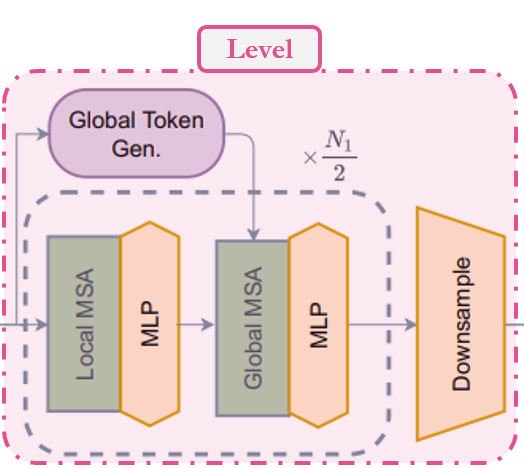
class Level(layers.Layer):
"""GCViT level.
Args:
depth: number of layers in each stage.
num_heads: number of heads in each stage.
window_size: window size in each stage.
keepdims: dims to keep in FeatureExtraction.
downsample: bool argument for down-sampling.
mlp_ratio: MLP ratio.
qkv_bias: bool argument for query, key, value learnable bias.
qk_scale: bool argument to scaling query, key.
drop: dropout rate.
attention_dropout: attention dropout rate.
path_drop: drop path rate.
layer_scale: layer scaling coefficient.
"""
def __init__(
self,
depth,
num_heads,
window_size,
keepdims,
downsample=True,
mlp_ratio=4.0,
qkv_bias=True,
qk_scale=None,
dropout=0.0,
attention_dropout=0.0,
path_drop=0.0,
layer_scale=None,
**kwargs,
):
super().__init__(**kwargs)
self.depth = depth
self.num_heads = num_heads
self.window_size = window_size
self.keepdims = keepdims
self.downsample = downsample
self.mlp_ratio = mlp_ratio
self.qkv_bias = qkv_bias
self.qk_scale = qk_scale
self.dropout = dropout
self.attention_dropout = attention_dropout
self.path_drop = path_drop
self.layer_scale = layer_scale
def build(self, input_shape):
path_drop = (
[self.path_drop] * self.depth
if not isinstance(self.path_drop, list)
else self.path_drop
)
self.blocks = [
Block(
window_size=self.window_size,
num_heads=self.num_heads,
global_query=bool(i % 2),
mlp_ratio=self.mlp_ratio,
qkv_bias=self.qkv_bias,
qk_scale=self.qk_scale,
dropout=self.dropout,
attention_dropout=self.attention_dropout,
path_drop=path_drop[i],
layer_scale=self.layer_scale,
name=f"blocks_{i}",
)
for i in range(self.depth)
]
self.down = ReduceSize(keepdims=False, name="downsample")
self.q_global_gen = GlobalQueryGenerator(self.keepdims, name="q_global_gen")
super().build(input_shape)
def call(self, inputs, **kwargs):
x = inputs
q_global = self.q_global_gen(x) # shape: (B, win_size, win_size, C)
for i, blk in enumerate(self.blocks):
if i % 2:
x = blk([x, q_global]) # shape: (B, H, W, C)
else:
x = blk([x]) # shape: (B, H, W, C)
if self.downsample:
x = self.down(x) # shape: (B, H//2, W//2, 2*C)
return x
模型
让我们直接跳到模型。从call方法中我们可以看到:1. 它从图像创建补丁嵌入。此层不会展平这些嵌入,这意味着此模块的输出将是(batch, height/window_size, width/window_size, embed_dim),而不是(batch, height x width/window_size^2, embed_dim)。2. 然后它应用Dropout模块,该模块随机将输入单元设置为0。3. 它将这些嵌入传递给一系列Level模块,我们称之为level,其中:1. 生成全局令牌1. 应用局部和全局注意力1. 最后应用下采样。4. 因此,经过n个级别后的输出形状为:(batch, width/window_size x 2^{n-1}, width/window_size x 2^{n-1}, embed_dim x 2^{n-1})。在最后一层,论文不使用下采样也不增加通道。5. 上述层的输出使用LayerNormalization模块进行归一化。6. 在头部,2D特征使用Pooling模块转换为1D特征。此模块后的输出形状为(batch, embed_dim x 2^{n-1})。7. 最后,池化后的特征发送到Dense/Linear模块进行分类。
总结:图像 →(补丁 + 嵌入)→ Dropout →(注意力 + 特征提取)→ 归一化 → 池化 → 分类
class GCViT(keras.Model):
"""GCViT model.
Args:
window_size: window size in each stage.
embed_dim: feature size dimension.
depths: number of layers in each stage.
num_heads: number of heads in each stage.
drop_rate: dropout rate.
mlp_ratio: MLP ratio.
qkv_bias: bool argument for query, key, value learnable bias.
qk_scale: bool argument to scaling query, key.
attention_dropout: attention dropout rate.
path_drop: drop path rate.
layer_scale: layer scaling coefficient.
num_classes: number of classes.
head_activation: activation function for head.
"""
def __init__(
self,
window_size,
embed_dim,
depths,
num_heads,
drop_rate=0.0,
mlp_ratio=3.0,
qkv_bias=True,
qk_scale=None,
attention_dropout=0.0,
path_drop=0.1,
layer_scale=None,
num_classes=1000,
head_activation="softmax",
**kwargs,
):
super().__init__(**kwargs)
self.window_size = window_size
self.embed_dim = embed_dim
self.depths = depths
self.num_heads = num_heads
self.drop_rate = drop_rate
self.mlp_ratio = mlp_ratio
self.qkv_bias = qkv_bias
self.qk_scale = qk_scale
self.attention_dropout = attention_dropout
self.path_drop = path_drop
self.layer_scale = layer_scale
self.num_classes = num_classes
self.head_activation = head_activation
self.patch_embed = PatchEmbed(embed_dim=embed_dim, name="patch_embed")
self.pos_drop = layers.Dropout(drop_rate, name="pos_drop")
path_drops = np.linspace(0.0, path_drop, sum(depths))
keepdims = [(0, 0, 0), (0, 0), (1,), (1,)]
self.levels = []
for i in range(len(depths)):
path_drop = path_drops[sum(depths[:i]) : sum(depths[: i + 1])].tolist()
level = Level(
depth=depths[i],
num_heads=num_heads[i],
window_size=window_size[i],
keepdims=keepdims[i],
downsample=(i < len(depths) - 1),
mlp_ratio=mlp_ratio,
qkv_bias=qkv_bias,
qk_scale=qk_scale,
dropout=drop_rate,
attention_dropout=attention_dropout,
path_drop=path_drop,
layer_scale=layer_scale,
name=f"levels_{i}",
)
self.levels.append(level)
self.norm = layers.LayerNormalization(axis=-1, epsilon=1e-05, name="norm")
self.pool = layers.GlobalAvgPool2D(name="pool")
self.head = layers.Dense(num_classes, name="head", activation=head_activation)
def build(self, input_shape):
super().build(input_shape)
self.built = True
def call(self, inputs, **kwargs):
x = self.patch_embed(inputs) # shape: (B, H, W, C)
x = self.pos_drop(x)
for level in self.levels:
x = level(x) # shape: (B, H_, W_, C_)
x = self.norm(x)
x = self.pool(x) # shape: (B, C__)
x = self.head(x)
return x
def build_graph(self, input_shape=(224, 224, 3)):
"""
ref: https://www.kaggle.com/code/ipythonx/tf-hybrid-efficientnet-swin-transformer-gradcam
"""
x = keras.Input(shape=input_shape)
return keras.Model(inputs=[x], outputs=self.call(x), name=self.name)
def summary(self, input_shape=(224, 224, 3)):
return self.build_graph(input_shape).summary()
构建模型
- 让我们使用上面解释过的所有模块构建一个完整的模型。我们将根据论文中提到的配置构建 **GCViT-XXTiny** 模型。
- 我们还将加载移植的官方预训练权重并尝试进行一些预测。
# Model Configs
config = {
"window_size": (7, 7, 14, 7),
"embed_dim": 64,
"depths": (2, 2, 6, 2),
"num_heads": (2, 4, 8, 16),
"mlp_ratio": 3.0,
"path_drop": 0.2,
}
ckpt_link = (
"https://github.com/awsaf49/gcvit-tf/releases/download/v1.1.6/gcvitxxtiny.keras"
)
# Build Model
model = GCViT(**config)
inp = ops.array(np.random.uniform(size=(1, 224, 224, 3)))
out = model(inp)
# Load Weights
ckpt_path = keras.utils.get_file(ckpt_link.split("/")[-1], ckpt_link)
model.load_weights(ckpt_path)
# Summary
model.summary((224, 224, 3))
Downloading data from https://github.com/awsaf49/gcvit-tf/releases/download/v1.1.6/gcvitxxtiny.keras
48767519/48767519 ━━━━━━━━━━━━━━━━━━━━ 0s 0us/step
Model: "gc_vi_t"
┏━━━━━━━━━━━━━━━━━━━━━━━━━━━━━━━━━━━━┳━━━━━━━━━━━━━━━━━━━━━━━━━━━━━━━┳━━━━━━━━━━━━━┓ ┃ Layer (type) ┃ Output Shape ┃ Param # ┃ ┡━━━━━━━━━━━━━━━━━━━━━━━━━━━━━━━━━━━━╇━━━━━━━━━━━━━━━━━━━━━━━━━━━━━━━╇━━━━━━━━━━━━━┩ │ input_layer (InputLayer) │ (None, 224, 224, 3) │ 0 │ ├────────────────────────────────────┼───────────────────────────────┼─────────────┤ │ patch_embed (PatchEmbed) │ (None, 56, 56, 64) │ 45,632 │ ├────────────────────────────────────┼───────────────────────────────┼─────────────┤ │ pos_drop (Dropout) │ (None, 56, 56, 64) │ 0 │ ├────────────────────────────────────┼───────────────────────────────┼─────────────┤ │ levels_0 (Level) │ (None, 28, 28, 128) │ 180,964 │ ├────────────────────────────────────┼───────────────────────────────┼─────────────┤ │ levels_1 (Level) │ (None, 14, 14, 256) │ 688,456 │ ├────────────────────────────────────┼───────────────────────────────┼─────────────┤ │ levels_2 (Level) │ (None, 7, 7, 512) │ 5,170,608 │ ├────────────────────────────────────┼───────────────────────────────┼─────────────┤ │ levels_3 (Level) │ (None, 7, 7, 512) │ 5,395,744 │ ├────────────────────────────────────┼───────────────────────────────┼─────────────┤ │ norm (LayerNormalization) │ (None, 7, 7, 512) │ 1,024 │ ├────────────────────────────────────┼───────────────────────────────┼─────────────┤ │ pool (GlobalAveragePooling2D) │ (None, 512) │ 0 │ ├────────────────────────────────────┼───────────────────────────────┼─────────────┤ │ head (Dense) │ (None, 1000) │ 513,000 │ └────────────────────────────────────┴───────────────────────────────┴─────────────┘
Total params: 11,995,428 (45.76 MB)
Trainable params: 11,995,428 (45.76 MB)
Non-trainable params: 0 (0.00 B)
预训练权重的健全性检查
img = keras.applications.imagenet_utils.preprocess_input(
chelsea(), mode="torch"
) # Chelsea the cat
img = ops.image.resize(img, (224, 224))[None,] # resize & create batch
pred = model(img)
pred_dec = keras.applications.imagenet_utils.decode_predictions(pred)[0]
print("\n# Image:")
plt.figure(figsize=(6, 6))
plt.imshow(chelsea())
plt.show()
print()
print("# Prediction (Top 5):")
for i in range(5):
print("{:<12} : {:0.2f}".format(pred_dec[i][1], pred_dec[i][2]))
Downloading data from https://storage.googleapis.com/download.tensorflow.org/data/imagenet_class_index.json
35363/35363 ━━━━━━━━━━━━━━━━━━━━ 0s 0us/step
# Image:

# Prediction (Top 5):
Egyptian_cat : 0.72
tiger_cat : 0.04
tabby : 0.03
crossword_puzzle : 0.01
panpipe : 0.00
微调 **GCViT** 模型
在以下单元格中,我们将在包含 104 个类别的 Flower 数据集上微调 **GCViT** 模型。
配置
# Model
IMAGE_SIZE = (224, 224)
# Hyper Params
BATCH_SIZE = 32
EPOCHS = 5
# Dataset
CLASSES = [
"dandelion",
"daisy",
"tulips",
"sunflowers",
"roses",
] # don't change the order
# Other constants
MEAN = 255 * np.array([0.485, 0.456, 0.406], dtype="float32") # imagenet mean
STD = 255 * np.array([0.229, 0.224, 0.225], dtype="float32") # imagenet std
AUTO = tf.data.AUTOTUNE
数据加载器
def make_dataset(dataset: tf.data.Dataset, train: bool, image_size: int = IMAGE_SIZE):
def preprocess(image, label):
# for training, do augmentation
if train:
if tf.random.uniform(shape=[]) > 0.5:
image = tf.image.flip_left_right(image)
image = tf.image.resize(image, size=image_size, method="bicubic")
image = (image - MEAN) / STD # normalization
return image, label
if train:
dataset = dataset.shuffle(BATCH_SIZE * 10)
return dataset.map(preprocess, AUTO).batch(BATCH_SIZE).prefetch(AUTO)
花卉数据集
train_dataset, val_dataset = tfds.load(
"tf_flowers",
split=["train[:90%]", "train[90%:]"],
as_supervised=True,
try_gcs=False, # gcs_path is necessary for tpu,
)
train_dataset = make_dataset(train_dataset, True)
val_dataset = make_dataset(val_dataset, False)
Downloading and preparing dataset 218.21 MiB (download: 218.21 MiB, generated: 221.83 MiB, total: 440.05 MiB) to /root/tensorflow_datasets/tf_flowers/3.0.1...
Dl Completed...: 0%| | 0/5 [00:00<?, ? file/s]
Dataset tf_flowers downloaded and prepared to /root/tensorflow_datasets/tf_flowers/3.0.1. Subsequent calls will reuse this data.
为花卉数据集重新构建模型
# Re-Build Model
model = GCViT(**config, num_classes=104)
inp = ops.array(np.random.uniform(size=(1, 224, 224, 3)))
out = model(inp)
# Load Weights
ckpt_path = keras.utils.get_file(ckpt_link.split("/")[-1], ckpt_link)
model.load_weights(ckpt_path, skip_mismatch=True)
model.compile(
loss="sparse_categorical_crossentropy", optimizer="adam", metrics=["accuracy"]
)
/usr/local/lib/python3.10/dist-packages/keras/src/saving/saving_lib.py:269: UserWarning: A total of 1 objects could not be loaded. Example error message for object <Dense name=head, built=True>:
Layer 'head' expected 2 variables, but received 0 variables during loading. Expected: ['kernel', 'bias']
List of objects that could not be loaded:
[<Dense name=head, built=True>]
warnings.warn(msg)
训练
history = model.fit(
train_dataset, validation_data=val_dataset, epochs=EPOCHS, verbose=1
)
Epoch 1/5
104/104 ━━━━━━━━━━━━━━━━━━━━ 153s 581ms/step - accuracy: 0.5140 - loss: 1.4615 - val_accuracy: 0.8828 - val_loss: 0.3485
Epoch 2/5
104/104 ━━━━━━━━━━━━━━━━━━━━ 7s 69ms/step - accuracy: 0.8775 - loss: 0.3437 - val_accuracy: 0.8828 - val_loss: 0.3508
Epoch 3/5
104/104 ━━━━━━━━━━━━━━━━━━━━ 7s 68ms/step - accuracy: 0.8937 - loss: 0.2918 - val_accuracy: 0.9019 - val_loss: 0.2953
Epoch 4/5
104/104 ━━━━━━━━━━━━━━━━━━━━ 7s 68ms/step - accuracy: 0.9232 - loss: 0.2397 - val_accuracy: 0.9183 - val_loss: 0.2212
Epoch 5/5
104/104 ━━━━━━━━━━━━━━━━━━━━ 7s 68ms/step - accuracy: 0.9456 - loss: 0.1645 - val_accuracy: 0.9210 - val_loss: 0.2897


